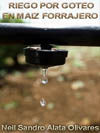
Neil Sandro Alata Olivares
Esta página muestra parte del texto pero sin formato.
Puede bajarse el libro completo en PDF comprimido ZIP (69 páginas, 212 kb) pulsando aquí
RESUMEN
Se estudió a 14 empresas agropecuarias de la Irrigación Majes antes y después de que adopten sistema de riego por goteo en maíz forrajero durante el 2005 en comparación al producido por aspersión en el 2004. Después que se adoptó el riego por goteo, se tuvo mayor rendimiento en maíz forrajero (101 TM vs 47 TM/Ha), diminuyó el costo unitario (de S/. 0.064 a S/. 0.055 por kilogramo) y mejoró el índice de rentabilidad al producido en el 2004 por riego por aspersión (1.49 vs 1.26). Se mejoró la producción de leche por vaca día promedio en las empresas que adoptaron el riego por goteo en maíz forrajero ( 16.87 vs 16.67 kilos leche/vaca/día), por tener mayor disponibilidad de dicho alimento en forma de ensilaje en la alimentación de vacas lecheras, producto del incremento de rendimiento. Se incrementó ingresos por leche promedio después que adoptaran el riego por goteo en maíz forrajero (S/. 84420.07 vs S/. 71242.81), mejoró la producción de leche promedio anual (114,745.4 Kg vs 99,388.6 Kg) y la calidad de leche con un mejor porcentaje de grasa ( 3.24 % vs 3.19 %). Se disminuyó el costo de alimentación ( de S/. 0.064 a S/. 0.055 por kilo ensilaje de maíz forrajero). Por el mayor rendimiento de maíz forrajero bajo riego por goteo durante el 2005, se tuvo mayor disponibilidad de alimento forrajero en forma de ensilaje de maíz en la ración alimenticia diaria de las vacas lecheras, mejorando el balance nutricional tanto en cantidad como en niveles adecuados de proteína y energía en la dieta diaria animal, favoreciendo mayor rendimiento de leche, mayor contenido en grasa y mayor ingreso por venta de leche en las empresas agropecuarias estudiadas.
ABSTRACTS
14 farming companies from Majes Irrigation Place were studied before and alter they adopted irrigation system in forage corn (Zea Mays) during 2005 in comparison to that forage corn cultivated by aspersion irrigation system in 2004.
After they adopted drip irrigation system, forage corn yield was bigger (101 vs 47 Tm/Ha), theirs unitary cost had depressed (of S/. 0.064 to S/. 0.055 for pound of forage corn ) and it improved the index of profitability to the one cultivated in 2004 by aspersion irrigation system (1.49 vs 1.26). The average production of milk was improved by cow-day in the farming companies that adopted the drip irrigation system in forage corn (16.87 vs 16.67 pounds of milk/cow/day). They had more availability of the aboved mentioned food in the shape of corn silage in the nourishment of dairy cows, because of the increase of forage corn yield.
Income was increase by average milk production after they were adopting the drip irrigation system in forage corn (S/. 84420.07 vs S/. 71242.81), the production of milk improved annual average (114,745.4 pounds vs 99,338.6 pounds) and the quality of milk with a better percentage of fat (3.24 % vs 3.19 %). The cost of nourishment was diminished (of S7. 0.064 to S7. 0.055 for pound of forage corn silage). For the bigger yield of forage corn by drip irrigation system during 2005, had major availability of forage food in the shape of corn silage in the nourishing daily ration of the dairy cows, improving the nutritional balance both in quantity and in suitable levels of protein and energy in the daily animal diet, increasing major yield of milk, more milk fat content and major revenue for sale of milk in the farming studied companies.

